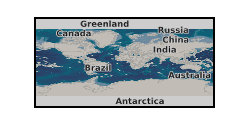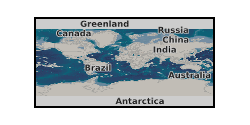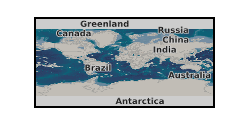Earth core
Type of resources
Available actions
Topics
Keywords
Contact for the resource
Provided by
Years
Formats
Update frequencies
-

The two-phase modeling of water between liquid iron and silicate melt at 50 and 135 gigapascals (corresponding to 3500 and 4200 kelvin) was performed by using ab initio molecular dynamics implemented in the Vienna Ab Initio Simulation Package.
-

This dataset contains VASP runs performed on several supercomputing services (Monsoon and ARCHER, and their successors Monsoon2 and ARCHER2) to calculate the chemical potentials of potassium in liquid iron mixtures and in liquid and solid silicate mixtures, and their distribution in the Earth’s core using density functional theory. Data are available for the chemical potentials of potassium and various other elements in iron and silicate liquid mixtures. These data were used to calculate chemical equilibrium between liquid iron alloys and Earth’s mantle materials. The present grant also supported work regarding the Si composition and thermal history of Earth’s liquid core. Results from VASP runs are also included in the uploaded dataset.
-

This dataset contains VASP runs performed on several supercomputing services (ARCHER, Monsoon, Thomas and Grace in the UK; Eos in the USA) to calculate the chemical potentials of liquid iron mixtures and solid ferropericlase at Earth's core conditions using density functional theory. Data are available for the chemical potentials of iron in MgFeO and oxygen in liquid FeSiO. These data were used to calculate the partitioning of oxygen between ferropericlase and Earth's liquid core and to analyse the chemical boundary layer above the CMB. The present grant also supported work regarding the homogeneous solid nucleation in iron and iron-oxygen mixtures at Earth's core conditions when dealing with the core paradox. Classical nucleation theory data and results from VASP runs and classical molecular dynamics runs performed on ARCHER and Eos (Oak Ridge, USA) are also included in the uploaded dataset. In addition, the present grant also supported research on the dynamics and evolution of the Earth's core, together with a study confirming the saturation of electrical resistivity of solid iron at Earth’s core conditions (these data were uploaded as part of a previous NERC Grant, NE/H02462X/1). Further details can be found in Davies, Pozzo and Alfe’ (2018, in press); Davies et al. (2018); Pozzo and Alfe’ (2016); Davies et al. (2015).
-

Multi anvil presses (MAPS) are used worldwide for high p/t work. The 'Walker cell' has made maps more accessible for earth sciences research. A Walker cell is installed at Daresbury allowing X-ray diffraction data to be obtained at high p/t simultaneously. Its 'inventor', Prof D. Walker, is visiting Daresbury and Manchester for 1 year from October, 1997, and he is working with the PI's in developing the equipment so that higher p will be attainable, with better controlled and calibrated t. In situ experiments will provide data on the molar volumes of garnets and CO2 as a function of p and t. The results will improve thermodynamic databases allowing relevant mantle mineral reactions to be calculated more robustly.
-

This proposal seeks to test the hypothesis that a mantle hotspot was responsible for generating boninite magmas in the Izu - Bonin - Mariana (IBM) arc during the middle Eocene. Reconstruction of the plate configuration at that time places the nascent IBM arc close to the location of the present Manus Basin, where a high 3He/4He hotspot has been identified through helium isotope data and tomographic imaging. This project will deliver: 3He/4He data for middle Eocene boninites to resolve the hotspot-present or hotspot-absent models for initiation of the IBM arc. Pb and O isotope ratios and U and Th concentration data to aid in constraining subduction and crustal contamination in the petrogenesis of these rocks. A framework for investigating Archean tectonics and volcanic massive sulphide deposits.
-

Olivine, the major component of the Earth's upper mantle, is known to contain water in the form of H defects. These defects have a significant effect on the physical and chemical properties of minerals. If we are to correctly interpret seismic data from the upper mantle, and to constrain models of its petrologic and geochemical evolution, then we must have information on the energies and mechanisms of water solubility in olivine, and its effects on physical properties. The aim of this project is to use computer simulation methods to predict the nature of H defects in olivine, their mobility, and their effects on elasticity as a function of pressure, and to use this information to better constrain models of dynamic behaviour of the Earth's upper mantle.
-

This dataset contains VASP runs performed on ARCHER to calculate the electrical and thermal conductivities of pure iron and iron alloys at Earth's core conditions using density functional theory with the Kubo-Greenwood formulation. Data are available for both the solid and the liquid phase characterising the inner and outer core respectively. Also included in the dataset the runs for computing the lattice contribution to the electrical resistivity of magnetic bcc iron at ambient pressure and two low temperatures and for computing the melting curve of fcc nickel. These data were also used for the modelling of the geodynamo and the thermal history of the Earth, to calculate the transport properties for silicon-oxygen-iron mixtures and to confirm the saturation of electrical resistivity of solid iron at Earth’s core conditions. The results from this dataset showed that both conductivities are much larger than previously thought with important implications for the geodynamo and the thermal history of the Earth, benefitting the geodynamo community. The results of our research have been recently confirmed by new experimental results obtained at Earth's core conditions. Further details can be found in Alfè et al. (2012); Pozzo et al. (2012, 2013a, 2013b, 2014, 2016); Gubbins et al. (2015); Davies et al. (2015). NERC Grant is NE/H02462X/1.
-

High-presicion Ar- Ar and U-Pb dating of magmatic events in the British Tertiary igneous province is difficult to reconcile with the magnetostratigraphy. The normally maganetised rocks of Mull Centres 2 and 3 are too old for C26N, much too young for C25N, and of too long a duration to fit into normal cryptpchrons in C26R. The most likely reason for this discrepancy is that the accepted time range of C26N (58-57.6 Ma) is too young by at least 0.5m.y. We propose to resolve the problem by re-determining the age of the Palaeocene-Ecocene boundary by Ar-Ar dating of sanidine from ash layers in northern Jutland. Our Ar-Ar dates will be checked against U-Pb ages of zircon and sphen from the Danish ashes and from the Hebrides.
-

One of the primary processes shaping Earth's surface is the stretching and eventual break-up of continents to create new ocean basins. The processes of stretching and heating of -150 km-thick plates, or layers of rock, are made evident at Earth's surface via earthquakes, volcanoes, hot springs, landslides and rockfalls that occur within and along the margins of narrow, long basins flanked by steep mountain ranges (e.g., East African rift, Gulf of Corinth). Ancient areas of stretching are more difficult to decipher, since the physical processes we wish to understand have since stopped, and competing processes of erosion, sedimentation, and subsidence of the rift zones makes them difficult to image. Finally, studies of continental break-up require an understanding of margins on both sides of ocean basins, which may now be 1000's of km apart (e.g., N. Atlantic). We propose to determine the evolution of continental rifting leading to break-up in the Gulf of Aden, where break-up occurred <20 My ago, and both margins are within a day's shiptime from one another. The short time interval since break-up means that sedimentary strata overlying the stretched, fractured, and heated rock layers of the plate are thin, and we can image clearly using geophysical methods. Our experiment involves the analyses of the travel times of seismic waves through the rock layers of the plates and underlying mantle where rocks are hotter, and where pockets of molten rock may have accumulated. Electronic devices capable of measuring vibrations from earthquakes worldwide (seismometers) will be buried along onshore continuations of profiles across the Gulf of Aden. We intend to use both man-made sound sources generated onboard the French seismic research vessel Marie Dufresne, which will travel along 3 profiles of the Gulf of Aden sending airblasts into the water every 50 metres. Our instruments will also record earthquakes occurring in the Himalayas, the Atlantic mid-ocean ridge, the Mediterranean sea, and the East African rift system. Variations in the arrival times of these sound waves recorded across our array allow us to map out velocity structure of the rocks beneath the array and across the width of the Gulf of Aden. Our aims are to map the geometry of the stretched layers within the plates, as well as their variations in velocity and physical properties. The velocity variations help us detect small variations in temperature and/or composition of the rocks, and help us determine the mechanical properties of the plates as they are stretched. Do the plates come apart along one large fracture, or fault zone, or does the stretching move continually inward to a narrow zone of necking, much like one finds stretching blue tack? Has some of the hot mantle rock which passively rises up to fill the place previously occupied by the plate depressurise and melt to form lavas? Where do these lavas form and rise up? Are these properties continuous along the length of the rift zone, or is the process three-dimensional? All of this information is vitally important to 1) oil explorationists trying to improve predictive models for oil and gas generation and migration 2) planners and government officials who need to evaluate seismic and volcanic hazards in areas of active rifting 3) earth scientists who wish to understand the physical properties of rocks so that we can adequately describe the physics of continental break-up and predict the onset of seafloor spreading. Funds are requested to cover travel to and from Oman to deploy instruments, to download data every 6 weeks (3 months) and every 12 weeks (9 months), plus travel to partner institutions to confer and integrate research results.
 NERC Data Catalogue Service
NERC Data Catalogue Service